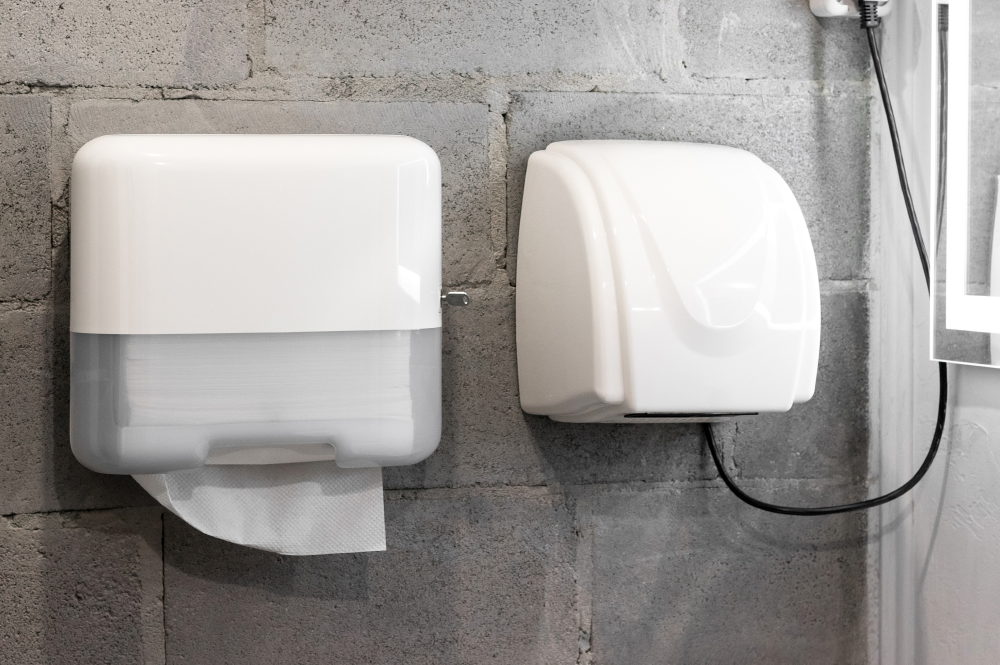Environmental Impact of Hand-Drying Methods – Paper Towels vs Hand Dryers

Eight years ago, we discussed the environmental impact of paper towels versus hand dryers. With advancements in technology and the availability of more eco-friendly hand dryers, we’ve revisited the topic.
Paper Towels
Paper towels have long been a common fixture in workplaces and restaurants; however, their popularity is declining as hand dryers become more widespread. While paper towels can be a good option in areas with high electricity costs or for hospitals where there is a concern about cross-contamination, they pose significant environmental concerns.
Paper towels generate a large amount of waste, as people often use more than necessary. They are frequently not recycled due to contamination and the presence of wet-strength agents, which prevent the fibres from breaking down when wet and make them unsuitable for recycling. Although some paper towels are made from recycled materials, they are often the last paper product in the recycling chain.
Additionally, paper towels contribute to greenhouse gas emissions, releasing methane into the atmosphere as they decompose in landfills.
Recycling Possibilities
Tork PaperCircle® is the first brand to offer recycling of paper hand towels, by creating towels that are derived from wood-based fibre and made with a water absorbent agent. Dedicated bins are supplied to workplaces to collect used towels, that are then recycled into new tissue products. The organisation claims that this process can help to reduce your carbon footprint by up to 40%.1
Hand Dryers
Hand dryers are a common choice for drying hands quickly, but what about their environmental impact?
Although the production of hand dryer machinery is power-intensive, requiring significant materials, there is no waste generated when compared to paper towels.
Hand dryers offer a more sustainable and cost-effective alternative, requiring fewer replacements, leading to reduced ongoing delivery costs and a smaller carbon footprint from transportation emissions.
Newer models consume significantly less energy, using as little as 0.6kW, leading to reduced CO2 emissions. These models demonstrate CO2 savings after 3,000 to 10,000 uses.
High Speed Air Dryers
High speed air dryers pump out powerful streams of cold air to blow water off the skin, compared to older models which use warm air to evaporate water off hands. These dryers have lower energy outputs than warm hand dryers, making them a more sustainable option. Additionally, they typically last for ten years, meaning there are less environmental costs associated with replacing them.
DryFlow hand dryers are the first in the world to be carbon neutral, encompassing their entire lifecycle from manufacturing and transport to usage and eventual disposal.
Hygiene
The hygiene of hand dryers is variable and depends on several factors. Models equipped with HEPA filters offer better hygiene compared to those without. Hand dryers operated by sensors are more hygienic as they eliminate the need for physical contact, thereby reducing germ transmission, unlike those requiring a button press, which pose a cross-contamination risk. Regular and thorough cleaning, along with consistent filter maintenance, also significantly impacts their hygienic performance.
Studies have shown that paper towels are superior to electric air dryers where hygiene is crucial, such as in hospitals.2
Outlook
It is difficult to directly compare the environmental impact of hand dryers and paper towels, as this depends on the quantity of paper towels used and the duration of hand dryer use. Nevertheless, each option has its advantages and is suitable in different contexts and environments.
In terms of the hygiene factor, it ultimately depends on the actual hand washing technique of the individual, regardless of the drying approach.


